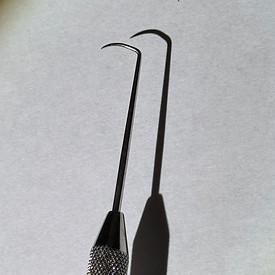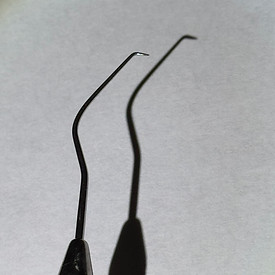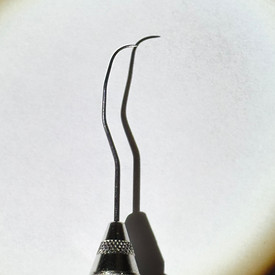Design Characteristics of Dental Explorers
Overall Design
-
Made of flexible metal
-
conducts vibrations from the working-end to the clinician’s fingers when resting on the instrument shank and handle.
-
-
Shank: flexible
-
enhances tactile sensitivity to locate calculus deposits beneath the gingival margin
-
-
Cross section: circular
-
Working-end:
-
paired or unpaired (not similar)
-
Example: One end is an explorer; Other end is a periodontal probe
-
-
length: 1 to 2 mm (referred to as explorer tip)
-
Explorer Tip

-
1-2 mm of the SIDE of the explorer
-
part of the explorer that is adapted to the tooth
-
NEVER use the point to detect calculus deposits
Lower Shank

-
Longer shank allows for tactile sensitivity
-
Middle finger rests lightly against the shank
Variety of Design Types
The dental hygienist should be knowledgeable about the
recommended use of each basic design type.
Note: All design types are not well suited to subgingival use.

Pigtail and Cowhorn Explorers
Design
-
Resembles a pig's tail or a bull's horn
Use
-
Detects calculus in normal sulci or shallow pockets
-
Extend no deeper than the cervical-third of the root
Advantages
-
Tip allows easier access to interproximal areas (between the teeth) and areas with tight spaces
Disadvantages
-
Curved lower shank causes stretching of the tissue away from the root surface.
Orban-Type Explorer

Design
-
Lower shank: straight
-
Tip: bent at 90 degrees to the lower shank
Use
-
detects subgingival calculus detection on:
-
Anterior root surfaces
-
Facial and lingual root surfaces of posterior teeth
-
Advantages
-
Bent tip allows the back of the tip (instead of the point) to be directed against the soft tissue base of the sulcus/pocket
-
Excellent for use on anterior teeth
Disadvantages
-
Straight shank makes it difficult to use on the line angles, mesial, and distal surfaces of posterior teeth
11/12 - Type Explorer

Design
-
Lower shank: long, complex
-
Tip: bent at 90-degree angle to lower shank
Use
-
Assessment of root surfaces
Advantages
-
Complex shank makes it easy to reach root surfaces
Disadvantages
-
NONE!
*The 11/12-type explorer works well throughout the mouth and can be used in healthy sulci and deep periodontal pockets.
*The 11/12 explorer will be the type that is used in the UH Maui College Dental Clinic.